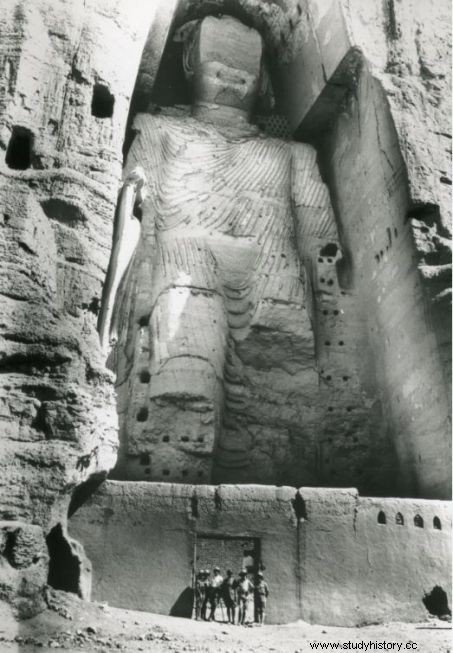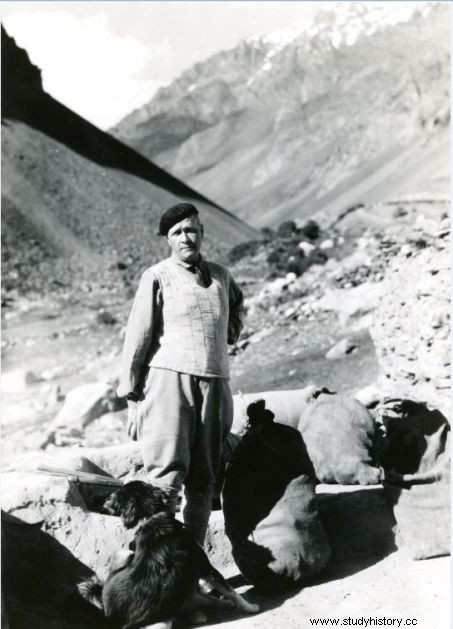Following the destruction of the two large sculpted Buddhas that adorned the cliff of Bamiyan, in Afghanistan, the Asian Arts Museum - Guimet in Paris has chosen to commemorate the 20th anniversary of their disappearance by devoting an exhibition to them from February 24 to June 21, 2021. .

Panoramic extract of the Bamiyan cliff, in Afghanistan.
On March 11, 2001, barely six months before the attacks on the World Trade Center in New York (United States), the two giant Buddhas of Bamiyan (Afghanistan) were blown to pieces, dynamited by the Taliban, in an unprecedented attack by the Taliban. a monument listed as a World Heritage Site by Unesco.
The gaping cells left by the two Bamiyan Buddhas
The premonitory destruction of these two impressive Buddhist remains 53 meters and 38 meters high thus brought the world into a 21st century shrouded in twilight. These two colossi stood on the famous Silk Road - which crossed the valley - since the 6th century, carved into a cliff at the foot of the Hindu Kush mountains, a hundred kilometers from Kabul. They left, still visible today, only large gaping cells.
 Empty niche of one of the two Bamiyan Cliff Buddhas, after destruction. Credits:Courtesy Pascal Convert
Empty niche of one of the two Bamiyan Cliff Buddhas, after destruction. Credits:Courtesy Pascal Convert
To commemorate this disappearance, the Guimet Museum in Paris has just inaugurated an exhibition-file entitled "Des images et des hommes, Bamiyan 20 ans après", recalling this adage repeatedly verified "what we do to images, we do to humans ". A mantra constantly repeated by Sophie Makariou, the president of the National Museum of Asian Arts, curator of the exhibition.
The West discovers the two Buddhas with the "Yellow Cruise"
Pending the hoped-for reopening of the museum at the end of the Covid-19 crisis, this exhibition (which can be visited virtually) has been installed on the third floor of the illustrious building on the Place d'Iéna and is expected to extend beyond June 21. In the space of 50 m 2 which serves as its setting, one is struck upon entering by the 16 meters of the spectacular panoramic photo, "imprint" of the current cliff of Bamiyan, taken from 4000 shots by the plastic photographer Pascal Convert. A restitution whose realism almost touches the texture of the rock. Reproduced by a photographic printing process used in the 19th century which uses platinum salts, the image becomes unalterable.
 Eastern part of the Bamiyan cliff (Afghanistan), and its remains of Buddhist caves. More than 700 have been occupied there for centuries. Credits:Courtesy Pascal Convert
Eastern part of the Bamiyan cliff (Afghanistan), and its remains of Buddhist caves. More than 700 have been occupied there for centuries. Credits:Courtesy Pascal Convert
Easterners have known of the existence of the Buddhist site of Bamiyan for centuries, its mention appearing in 5th century Chinese texts and in 9th century chronicles written by Arab and Iranian authors, like the Muslim scholar Al-Bîrûni (973-1048). But it is above all through photos taken from the 19th century, and mainly in the 1930s during the "Yellow Cruise", the famous automobile raid organized by André Citroën, that the West truly discovered the two Buddhas that the locals affectionately called "Salsal (light illuminates the Universe) and "Shamana " (Queen Mother).
 The Great Buddha of Bamiyan photographed in the 1930s. Credits:MNAAG Photo Archive
The Great Buddha of Bamiyan photographed in the 1930s. Credits:MNAAG Photo Archive
East and West, these worlds hitherto at the antipodes, had in fact already crossed paths 2200 years earlier, in the 4th century BC, when the armies of Alexander the Great had reached the banks of the Indus in 333 BC. . J.C. Hence these Indian and Greek influences and the artistic movement known as Gandhara art (formerly called Greco-Buddhist) from which the Buddhas of Bamiyan come precisely. Buddhas whose image was represented for the first time in human form.
 This hand of Buddha gilded with gold leaf is one of the few surviving Buddhist remains, originating from the Bamiyan site, kept at the Guimet Museum in Paris. Credits:MNAAG
This hand of Buddha gilded with gold leaf is one of the few surviving Buddhist remains, originating from the Bamiyan site, kept at the Guimet Museum in Paris. Credits:MNAAG
The Hackin couple, pioneers of archeology
The Musée Guimet exhibition is also an opportunity to return to the special links maintained between Afghanistan and French archaeology, with showcases dedicated to the couple of archaeologist diggers from Bamiyan, Ria and Joseph Hackin (1905-1941 and 1886-1941), curators of the Asian Art Museum in Paris. The work of these pioneering researchers in Afghanistan is presented through letters, drawings, photos and field notebooks. So many precious testimonies before their tragic death during the Second World War. The opening date of the exhibition on February 24, 2021 was indeed chosen to pay tribute to the 80th anniversary, to the day, of their disappearance off the coast of the Faroe Islands after the ship on which these two resistance fighters, companions of the Order of the Liberation and rallied from the first hours to General de Gaulle, was torpedoed.
 Portrait of Joseph Hackin (1886-1941) archaeologist and former director of the Guimet Museum, in Paris. Credits:MNAAG Photographic Archives
Portrait of Joseph Hackin (1886-1941) archaeologist and former director of the Guimet Museum, in Paris. Credits:MNAAG Photographic Archives
"We wanted to give a vision of resistance to the destruction of the Bamiyan cliff which irrigates this exhibition dedicated to the Hackin couple but which also animates the Hazara Shiite populations, a minority, who continue to live in this valley", insists Sophie Makariou. "Buddhas died like men, we live like stones" , had summed up in a poignant sentence a Hazara woman to the journalist Florence Aubenas, in 2002.
 Gouache on canvas of Bodhisattvas from Cave K of Bamiyan, made by Jean Carl, in 1935. Credits:MNAAG/RMN
Gouache on canvas of Bodhisattvas from Cave K of Bamiyan, made by Jean Carl, in 1935. Credits:MNAAG/RMN
After this blasting and the other iconoclastic destruction that accompanied it, nothing remains today of the Buddhist frescoes that were visible in the 700 caves dug into the Bamiyan cliff. Never shown, the surveys carried out by archaeologists in the 1930s presented in the exhibition are today the only and unique traces. These copies now have the value of originals, some of them executed by the architect Jean Carl, a friend of the Hackin couple, who worked with them in Afghanistan and who committed suicide on learning of their death. Thanks to the system of sharing excavations in progress in the 1930s, three hands of Buddhas from Bamiyan have been preserved in the Guimet Museum. They are the only surviving remnants of the cliff, those that were in the Kabul museum having all been destroyed by the Taliban during the capture of the Afghan capital in 1996. One of these hands still bears traces of leaves of gold, symbol of the radiant flesh of the Buddha. The Louvre-Lens, in partnership with the National Center for Plastic Arts (Cnap) will also commemorate this event from March 11 by presenting other photos by Pascal Convert.
